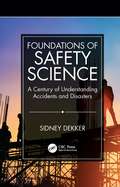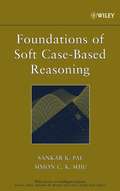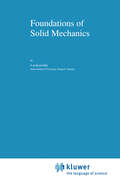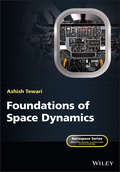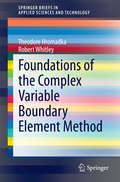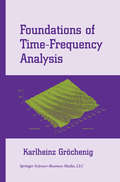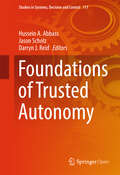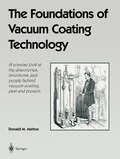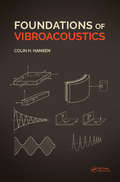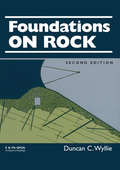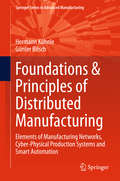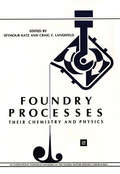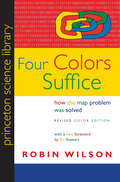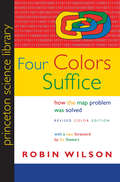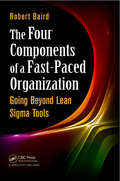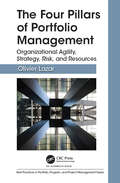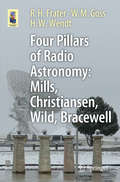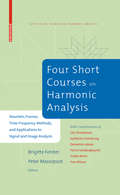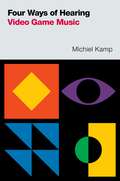- Table View
- List View
Foundations of Safety Science: A Century of Understanding Accidents and Disasters
by Sidney DekkerHow are today’s ‘hearts and minds’ programs linked to a late-19th century definition of human factors as people’s moral and mental deficits? What do Heinrich’s ‘unsafe acts’ from the 1930’s have in common with the Swiss cheese model of the early 1990’s? Why was the reinvention of human factors in the 1940’s such an important event in the development of safety thinking? What makes many of our current systems so complex and impervious to Tayloristic safety interventions? ‘Foundations of Safety Science’ covers the origins of major schools of safety thinking, and traces the heritage and interlinkages of the ideas that make up safety science today. Features Offers a comprehensive overview of the theoretical foundations of safety science Provides balanced treatment of approaches since the early 20th century, showing interlinkages and cross-connections Includes an overview and key points at the beginning of each chapter and study questions at the end to support teaching use Uses an accessible style, using technical language where necessary Concentrates on the philosophical and historical traditions and assumptions that underlie all safety approaches
Foundations of Soft Case-Based Reasoning (Wiley Series on Intelligent Systems #8)
by Sankar K. Pal Simon C. ShiuProvides a self-contained description of this important aspect of information processing and decision support technology. Presents basic definitions, principles, applications, and a detailed bibliography. Covers a range of real-world examples including control, data mining, and pattern recognition.
Foundations of Solid Mechanics (Solid Mechanics and Its Applications #3)
by P. KarasudhiThis book has been written with two purposes, as a textbook for engineering courses and as a reference book for engineers and scientists. The book is an outcome of several lecture courses. These include lectures given to graduate students at the Asian Institute of Technology for several years, a course on elasticity for University of Tokyo graduate students in the spring of 1979, and courses on elasticity, viscoelasticity and ftnite deformation at the National University of Singapore from May to November 1985. In preparing this book, I kept three objectives in mind: ftrst, to provide sound fundamental knowledge of solid mechanics in the simplest language possible; second, to introduce effective analytical and numerical solution methods; and third, to impress on readers that the subject is beautiful, and is accessible to those with only a standard mathematical background. In order to meet those objectives, the ftrst chapter of the book is a review of mathematical foundations intended for anyone whose background is an elementary knowledge of differential calculus, scalars and vectors, and Newton's laws of motion. Cartesian tensors are introduced carefully. From then on, only Cartesian tensors in the indicial notation, with subscript as indices, are used to derive and represent all theories.
Foundations of Space Dynamics (Aerospace Series)
by Ashish TewariFoundations of Space Dynamics offers an authoritative text that combines a comprehensive review of both orbital mechanics and dynamics. The author—a noted expert on the topic—covers up-to-date topics including: orbital perturbations, Lambert's transfer, formation flying, and gravity-gradient stabilization. The text provides an introduction to space dynamics in its entirety, including important analytical derivations and practical space flight examples. Written in an accessible and concise style, Foundations of Space Dynamics highlights analytical development and rigor, rather than numerical solutions via ready-made computer codes. To enhance learning, the book is filled with helpful tables, figures, exercises, and solved examples. This important book: Covers space dynamics with a systematic and comprehensive approach Designed to be a practical text filled with real-world examples Contains information on the most current applications Includes up-to-date topics from orbital perturbations to gravity-gradient stabilization Offers a deep understanding of space dynamics often lacking in other textbooks Written for undergraduate and graduate students and professionals in aerospace engineering, Foundations of Space Dynamics offers an introduction to the most current information on orbital mechanics and dynamics.
Foundations of Space Dynamics (Aerospace Series)
by Ashish TewariFoundations of Space Dynamics offers an authoritative text that combines a comprehensive review of both orbital mechanics and dynamics. The author—a noted expert on the topic—covers up-to-date topics including: orbital perturbations, Lambert's transfer, formation flying, and gravity-gradient stabilization. The text provides an introduction to space dynamics in its entirety, including important analytical derivations and practical space flight examples. Written in an accessible and concise style, Foundations of Space Dynamics highlights analytical development and rigor, rather than numerical solutions via ready-made computer codes. To enhance learning, the book is filled with helpful tables, figures, exercises, and solved examples. This important book: Covers space dynamics with a systematic and comprehensive approach Designed to be a practical text filled with real-world examples Contains information on the most current applications Includes up-to-date topics from orbital perturbations to gravity-gradient stabilization Offers a deep understanding of space dynamics often lacking in other textbooks Written for undergraduate and graduate students and professionals in aerospace engineering, Foundations of Space Dynamics offers an introduction to the most current information on orbital mechanics and dynamics.
Foundations of the Complex Variable Boundary Element Method (SpringerBriefs in Applied Sciences and Technology)
by Theodore Hromadka Robert WhitleyThis book explains and examines the theoretical underpinnings of the Complex Variable Boundary Element Method (CVBEM) as applied to higher dimensions, providing the reader with the tools for extending and using the CVBEM in various applications. Relevant mathematics and principles are assembled and the reader is guided through the key topics necessary for an understanding of the development of the CVBEM in both the usual two as well as three or higher dimensions. In addition to this, problems are provided that build upon the material presented. The Complex Variable Boundary Element Method (CVBEM) is an approximation method useful for solving problems involving the Laplace equation in two dimensions. It has been shown to be a useful modelling technique for solving two-dimensional problems involving the Laplace or Poisson equations on arbitrary domains. The CVBEM has recently been extended to 3 or higher spatial dimensions, which enables the precision of the CVBEM in solving the Laplace equation to be now available for multiple dimensions. The mathematical underpinnings of the CVBEM, as well as the extension to higher dimensions, involve several areas of applied and pure mathematics including Banach Spaces, Hilbert Spaces, among other topics. This book is intended for applied mathematics graduate students, engineering students or practitioners, developers of industrial applications involving the Laplace or Poisson equations and developers of computer modelling applications.
Foundations of Time-Frequency Analysis (Applied and Numerical Harmonic Analysis)
by Karlheinz GröchenigTime-frequency analysis is a modern branch of harmonic analysis. It com prises all those parts of mathematics and its applications that use the struc ture of translations and modulations (or time-frequency shifts) for the anal ysis of functions and operators. Time-frequency analysis is a form of local Fourier analysis that treats time and frequency simultaneously and sym metrically. My goal is a systematic exposition of the foundations of time-frequency analysis, whence the title of the book. The topics range from the elemen tary theory of the short-time Fourier transform and classical results about the Wigner distribution via the recent theory of Gabor frames to quantita tive methods in time-frequency analysis and the theory of pseudodifferential operators. This book is motivated by applications in signal analysis and quantum mechanics, but it is not about these applications. The main ori entation is toward the detailed mathematical investigation of the rich and elegant structures underlying time-frequency analysis. Time-frequency analysis originates in the early development of quantum mechanics by H. Weyl, E. Wigner, and J. von Neumann around 1930, and in the theoretical foundation of information theory and signal analysis by D.
Foundations of Trusted Autonomy (Studies in Systems, Decision and Control #117)
by Hussein A. Abbass Jason Scholz Darryn J. ReidThis book establishes the foundations needed to realize the ultimate goals for artificial intelligence, such as autonomy and trustworthiness. Aimed at scientists, researchers, technologists, practitioners, and students, it brings together contributions offering the basics, the challenges and the state-of-the-art on trusted autonomous systems in a single volume. The book is structured in three parts, with chapters written by eminent researchers and outstanding practitioners and users in the field. The first part covers foundational artificial intelligence technologies, while the second part covers philosophical, practical and technological perspectives on trust. Lastly, the third part presents advanced topics necessary to create future trusted autonomous systems. The book augments theory with real-world applications including cyber security, defence and space.
Foundations of Ultra-Precision Mechanism Design
by Stuart T. SmithThe realm of ultra precision mechanisms, for example in controlling motion to small fractions of a micrometer, is encroaching into many fields of technology. This book aims to provide a bridge for those moving from either an engineering or physics background towards the challenges offered by ultraprecision mechanisms. Using case study examples, this book provides a guide to basic techniques and gives technical, analytical and practical information.
Foundations of Ultra-Precision Mechanism Design
by Stuart T. SmithThe realm of ultra precision mechanisms, for example in controlling motion to small fractions of a micrometer, is encroaching into many fields of technology. This book aims to provide a bridge for those moving from either an engineering or physics background towards the challenges offered by ultraprecision mechanisms. Using case study examples, this book provides a guide to basic techniques and gives technical, analytical and practical information.
The Foundations of Vacuum Coating Technology
by Donald M. MattoxIntroduction . . . . . . . . . . . . . . . . . . . . . . . . . . . . . . . . . . . . . . . . . . . . . . . . . . . . . . . . . . . . . . . . . . . . . . . . . . . . . . . . . . . . . . . . . . . . . . . . . . . . . . . . . . . . . . . . . . . . . . . . . . . . . . . . . . . . . . . . . . . . . . . . . . . . . . . . . . . . 1 Early Vacuum Science and Technology . . . . . . . . . . . . . . . . . . . . . . . . . . . . . . . . . . . . . . . . . . . . . . . . . . . . . . . . . . . . . . . . . . . . . . . . . . . . . . . . . . . . . . . . . . . . . . . . . . . . . . . . . . . . . . . . . 2 Early Electricity and Magnetism . . . . . . . . . . . . . . . . . . . . . . . . . . . . . . . . . . . . . . . . . . . . . . . . . . . . . . . . . . . . . . . . . . . . . . . . . . . . . . . . . . . . . . . . . . . . . . . . . . . . . . . . . . . . . . . . . . . . . . . . . . . . 5 Early Plasma Physics and Chemistry . . . . . . . . . . . . . . . . . . . . . . . . . . . . . . . . . . . . . . . . . . . . . . . . . . . . . . . . . . . . . . . . . . . . . . . . . . . . . . . . . . . . . . . . . . . . . . . . . . . . . . . . . . . . . . . . . . . . . 7 Some Scientific and Engineering Societies and Publications . . . . . . . . . . . . . . . . . . . . . . . . . . . . . . . . . . . . . . . . . . . . . . . . . . . . . . . . . . . . . . . . . . . . . . . . . . . . . . . . 9 Patents and the U. S. Patent Office . . . . . . . . . . . . . . . . . . . . . . . . . . . . . . . . . . . . . . . . . . . . . . . . . . . . . . . . . . . . . . . . . . . . . . . . . . . . . . . . . . . . . . . . . . . . . . . . . . . . . . . . . . . . . . . . . . . . . . . 10 Deposition Processes . . . . . . . . . . . . . . . . . . . . . . . . . . . . . . . . . . . . . . . . . . . . . . . . . . . . . . . . . . . . . . . . . . . . . . . . . . . . . . . . . . . . . . . . . . . . . . . . . . . . . . . . . . . . . . . . . . . . . . . . . . . . . . . . . . . . . . . . . . . . 11 Sputter Deposition . . . . . . . . . . . . . . . . . . . . . . . . . . . . . . . . . . . . . . . . . . . . . . . . . . . . . . . . . . . . . . . . . . . . . . . . . . . . . . . . . . . . . . . . . . . . . . . . . . . . . . . . . . . . . . . . . . . . . . . . . . . . . . . . . . . . . . . . . 11 Thermal Evaporation . . . . . . . . . . . . . . . . . . . . . . . . . . . . . . . . . . . . . . . . . . . . . . . . . . . . . . . . . . . . . . . . . . . . . . . . . . . . . . . . . . . . . . . . . . . . . . . . . . . . . . . . . . . . . . . . . . . . . . . . . . . . . . . . . . . . . 19 Arc Vapor Deposition . . . . . . . . . . . . . . . . . . . . . . . . . . . . . . . . . . . . . . . . . . . . . . . . . . . . . . . . . . . . . . . . . . . . . . . . . . . . . . . . . . . . . . . . . . . . . . . . . . . . . . . . . . . . . . . . . . . . . . . . . . . . . . . . . . . . 24 Chemical Vapor Deposition . . . . . . . . . . . . . . . . . . . . . . . . . . . . . . . . . . . . . . . . . . . . . . . . . . . . . . . . . . . . . . . . . . . . . . . . . . . . . . . . . . . . . . . . . . . . . . . . . . . . . . . . . . . . . . . . . . . . . . . . . . . 27 Ion Plating . . . . . . . . . . . . . . . . . . . . . . . . . . . . . . . . . . . . . . . . . . . . . . . . . . . . . . . . . . . . . . . . . . . . . . . . . . . . . . . . . . . . . . . . . . . . . . . . . . . . . . . . . . . . . . . . . . . . . . . . . . . . . . . . . . . . . . . . . . . . . . . . . . . . . . 30 Surface Preparation . . . . . . . . . . . . . . . . . . . . . . . . . . . . . . . . . . . . . . . . . . . . . . . . . . . . . . . . . . . . . . . . . . . . . . . . . . . . . . . . . . . . . . . . . . . . . . . . . . . . . . . . . . . . . . . . . . . . . . . . . . . . . . . . . . . . . . . . . . . . . . 34 Summary . . . . . . . . . . . . . . . . . . . . . . . . . . . . . . . . . . . . . . . . . . . . . . . . . . . . . . . . . . . . . . . . . . . . . . . . . . . . . . . . . . . . . . . . . . . . . . . . . . . . . . . . . . . . . . . . . . . . . . . . . . . . . . . . . . . . . . . . . . . . . . . . . . . . . . . . . . . . . . 37 Endnotes . . . . . . . . . . . . . . . . . . . . . .
Foundations of Vibroacoustics
by Colin HansenThis text provides the foundation material for solving problems in vibroacoustics. These include the prediction of structural vibration levels and sound pressure levels in enclosed spaces resulting from known force or acoustic pressure excitations and the prediction of sound levels radiated by vibrating structures. The book also provides an excellent theoretical basis for understanding the processes involved in software that predicts structural vibration levels and structural sound radiation resulting from force excitation of the structure, as well as sound levels in enclosed spaces resulting from vibration of part of the enclosing structure or resulting from acoustic sources within the enclosure. The book is written in an easy to understand style with detailed explanations of important concepts. It begins with fundamental concepts in vibroacoustics and provides a framework for problem solution in both low and high frequency ranges. It forms a primer for students, and for those already well versed in vibroacoustics, the book provides an extremely useful reference. It offers a unified treatment of both acoustics and vibration fundamentals to provide a basis for solving problems involving structural vibration, sound radiation from vibrating structures, sound in enclosed spaces, and propagation of sound and vibration.
Foundations of Vibroacoustics
by Colin HansenThis text provides the foundation material for solving problems in vibroacoustics. These include the prediction of structural vibration levels and sound pressure levels in enclosed spaces resulting from known force or acoustic pressure excitations and the prediction of sound levels radiated by vibrating structures. The book also provides an excellent theoretical basis for understanding the processes involved in software that predicts structural vibration levels and structural sound radiation resulting from force excitation of the structure, as well as sound levels in enclosed spaces resulting from vibration of part of the enclosing structure or resulting from acoustic sources within the enclosure. The book is written in an easy to understand style with detailed explanations of important concepts. It begins with fundamental concepts in vibroacoustics and provides a framework for problem solution in both low and high frequency ranges. It forms a primer for students, and for those already well versed in vibroacoustics, the book provides an extremely useful reference. It offers a unified treatment of both acoustics and vibration fundamentals to provide a basis for solving problems involving structural vibration, sound radiation from vibrating structures, sound in enclosed spaces, and propagation of sound and vibration.
Foundations on Rock: Engineering Practice, Second Edition
by Duncan C. WyllieThis second edition of the successful Foundations on Rock presents an up-to-date practical reference book describing current engineering practice in the investigation, design and construction of foundations on rock. An extra chapter on Tension Foundations has been included. The methods set out are readily applicable to high rise buildings, bridges,
Foundations & Principles of Distributed Manufacturing: Elements of Manufacturing Networks, Cyber-Physical Production Systems and Smart Automation (Springer Series in Advanced Manufacturing)
by Hermann Kühnle Günter BitschThe book presents a coherent description of distributed manufacturing, providing a solid base for further research on the subject as well as smart implementations in companies. It provides a guide for those researching and working in a range of fields, such as smart manufacturing, cloud computing, RFID tracking, distributed automation, cyber physical production and global design anywhere, manufacture anywhere solutions. Foundations & Principles of Distributed Manufacturing anticipates future advances in the fields of embedded systems, the Internet of Things and cyber physical systems, outlining how adopting these innovations could rapidly bring about improvements in key performance indicators, which could in turn generate competition pressure by rendering successful business models obsolete. In laying the groundwork for powerful theoretical models, high standards for the homogeneity and soundness of the suggested setups are applied. The book especially elaborates on the upcoming competition in online manufacturing operations and respective control procedures.By outlining encapsulation and evolving decision-making principles, Foundations & Principles of Distributed Manufacturing fully conceptualizes the view of manufacturing networks as sets of loosely coupled interacting smart factory objects. Moreover, the book provides concrete approaches to a number of future fields, where distributed manufacturing might be applied. Both researchers and professionals will profit from the authors’ broad experience in Distributed Manufacturing and Fractal Enterprise implementations, where they initiated and completed a number of successful research projects: within the global Intelligent Manufacturing Systems (IMS) scheme, within the European Research Area frameworks as well as national contexts, and both in industry and at leading research institutions. This background ensures well-founded theory on one hand and valuable practical results on the other in a fascinating area that is still under intensive research. Readers will acquire essential insights as well as useful guidance for categorizing and specifying extended distributed manufacturing solutions and their professional implementations.
Foundry Processes: Their Chemistry and Physics
by Seymour KatzFor a number of years it has been a General Motors Research Laboratories custom to hold a symposium on a subject which is new and emerging, and to invite the best people in the world in that subject to come together to talk to each other. Initially, I had some difficulty in regarding foundry processes as a new and emerging subject. Copper alloys have been in foundry practice for about six thousand years. Foundrymen working with those alloys have been recognized, as such, for nearly all that time. Iron has a much shorter history, probably only three or four thousand years. So what's new? What is new is that a subject which has always been so complex and so difficult that it could only be a craft skill, with bits and pieces of knowledge and bits and pieces of insight, has begun to yield to new abilities to solve very complex problems. We do this now because we can handle great amounts of data by computational means, using new and more complicated theoretical treatments than we could deal with before. In fact, we have a new technology with which we can attack these terribly difficult problems. Thus, foundry processing is becoming a new subject because new things can be done with it.
Four Colors Suffice: How the Map Problem Was Solved - Revised Color Edition (Princeton Science Library #128)
by Robin WilsonOn October 23, 1852, Professor Augustus De Morgan wrote a letter to a colleague, unaware that he was launching one of the most famous mathematical conundrums in history--one that would confound thousands of puzzlers for more than a century. This is the amazing story of how the "map problem" was solved. The problem posed in the letter came from a former student: What is the least possible number of colors needed to fill in any map (real or invented) so that neighboring counties are always colored differently? This deceptively simple question was of minimal interest to cartographers, who saw little need to limit how many colors they used. But the problem set off a frenzy among professional mathematicians and amateur problem solvers, among them Lewis Carroll, an astronomer, a botanist, an obsessive golfer, the Bishop of London, a man who set his watch only once a year, a California traffic cop, and a bridegroom who spent his honeymoon coloring maps. In their pursuit of the solution, mathematicians painted maps on doughnuts and horseshoes and played with patterned soccer balls and the great rhombicuboctahedron. It would be more than one hundred years (and countless colored maps) later before the result was finally established. Even then, difficult questions remained, and the intricate solution--which involved no fewer than 1,200 hours of computer time--was greeted with as much dismay as enthusiasm. Providing a clear and elegant explanation of the problem and the proof, Robin Wilson tells how a seemingly innocuous question baffled great minds and stimulated exciting mathematics with far-flung applications. This is the entertaining story of those who failed to prove, and those who ultimately did prove, that four colors do indeed suffice to color any map. This new edition features many color illustrations. It also includes a new foreword by Ian Stewart on the importance of the map problem and how it was solved.
Four Colors Suffice: How the Map Problem Was Solved
by Robin Wilson Ian StewartOn October 23, 1852, Professor Augustus De Morgan wrote a letter to a colleague, unaware that he was launching one of the most famous mathematical conundrums in history--one that would confound thousands of puzzlers for more than a century. This is the amazing story of how the "map problem" was solved. The problem posed in the letter came from a former student: What is the least possible number of colors needed to fill in any map (real or invented) so that neighboring counties are always colored differently? This deceptively simple question was of minimal interest to cartographers, who saw little need to limit how many colors they used. But the problem set off a frenzy among professional mathematicians and amateur problem solvers, among them Lewis Carroll, an astronomer, a botanist, an obsessive golfer, the Bishop of London, a man who set his watch only once a year, a California traffic cop, and a bridegroom who spent his honeymoon coloring maps. In their pursuit of the solution, mathematicians painted maps on doughnuts and horseshoes and played with patterned soccer balls and the great rhombicuboctahedron. It would be more than one hundred years (and countless colored maps) later before the result was finally established. Even then, difficult questions remained, and the intricate solution--which involved no fewer than 1,200 hours of computer time--was greeted with as much dismay as enthusiasm. Providing a clear and elegant explanation of the problem and the proof, Robin Wilson tells how a seemingly innocuous question baffled great minds and stimulated exciting mathematics with far-flung applications. This is the entertaining story of those who failed to prove, and those who ultimately did prove, that four colors do indeed suffice to color any map. This new edition features many color illustrations. It also includes a new foreword by Ian Stewart on the importance of the map problem and how it was solved.
The Four Components of a Fast-Paced Organization: Going Beyond Lean Sigma Tools
by Robert BairdIf you examine the characteristics of successful organizations, you will find that speed is a common denominator. Once there is a focus on speed, industry-leading improvements follow, momentum is created, and employees become further engaged to continue executing the strategy.The Four Components of a Fast-Paced Organization: Going Beyond Lean Sigma
The Four Pillars of Portfolio Management: Organizational Agility, Strategy, Risk, and Resources (Best Practices in Portfolio, Program, and Project Management)
by Olivier LazarPortfolio management consists mainly of making decisions about which initiatives to undertake, which initiatives not to pursue, and which resources are to be allocated to which portfolio component. At least, that’s how it is most commonly presented in textbooks and courses. Indeed, it is all of that, but it is also so much more. Portfolio management is, of course, about making these decisions, but, more accurately, it is about making them with the goal of creating value for an organization’s wide population of stakeholders, both internal and external. This value is not only expressed in financial terms but also in social terms. The portfolio should create value for all stakeholders, who thereby support the portfolio organization and enable it to sustain itself. Portfolio management is about the realization of strategic vision, achieving a purpose, and developing an intelligent way of using resources to benefit stakeholders. This requires the ability to find a balance among the different dimensions of portfolio governance and among the constraints constantly shaping and reshaping the business environment. This is what portfolio management is truly about; this is what organizational management is about. The Four Pillars of Portfolio Management: Organizational Agility, Strategy, Risk, and Resources takes readers on a journey navigating the dimensions and constraints to be balanced and integrated as part of the portfolio and organizational decision-making process. By balancing the requirements of strategic alignment with the exposure to risk and by reconciling resource demands with capability, a portfolio manager can develop and sustain an organization despite the constant and dynamic evolution of the business environment. This book explains how to manage portfolios that create the agility all organizations require to survive and thrive.
The Four Pillars of Portfolio Management: Organizational Agility, Strategy, Risk, and Resources (Best Practices in Portfolio, Program, and Project Management)
by Olivier LazarPortfolio management consists mainly of making decisions about which initiatives to undertake, which initiatives not to pursue, and which resources are to be allocated to which portfolio component. At least, that’s how it is most commonly presented in textbooks and courses. Indeed, it is all of that, but it is also so much more. Portfolio management is, of course, about making these decisions, but, more accurately, it is about making them with the goal of creating value for an organization’s wide population of stakeholders, both internal and external. This value is not only expressed in financial terms but also in social terms. The portfolio should create value for all stakeholders, who thereby support the portfolio organization and enable it to sustain itself. Portfolio management is about the realization of strategic vision, achieving a purpose, and developing an intelligent way of using resources to benefit stakeholders. This requires the ability to find a balance among the different dimensions of portfolio governance and among the constraints constantly shaping and reshaping the business environment. This is what portfolio management is truly about; this is what organizational management is about. The Four Pillars of Portfolio Management: Organizational Agility, Strategy, Risk, and Resources takes readers on a journey navigating the dimensions and constraints to be balanced and integrated as part of the portfolio and organizational decision-making process. By balancing the requirements of strategic alignment with the exposure to risk and by reconciling resource demands with capability, a portfolio manager can develop and sustain an organization despite the constant and dynamic evolution of the business environment. This book explains how to manage portfolios that create the agility all organizations require to survive and thrive.
Four Pillars of Radio Astronomy: Mills, Christiansen, Wild, Bracewell (Astronomers' Universe)
by R. H. Frater W. M. Goss H. W. WendtThis is the story of Bernie Mills, Chris Christiansen, Paul Wild and Ron Bracewell, members of a team of radio astronomers that would lead Australia, and the world, into this new field of research. Each of the four is remembered for his remarkable work: Mills for the development the cross type instrument that now bears his name; Christiansen for the application of rotational synthesis techniques; Wild for the masterful joining of observations and theory to elicit the nature of the solar atmosphere; Bracewell for his contribution to imaging theory. As well, these Four Pillars are remembered for creating a remarkable environment for scientific discovery and for influencing the careers of future generations. Their pursuit of basic science helped pave the way for technological developments in areas ranging from Wi-Fi to sonar to medical imaging to air navigation, and for underpinning the foundations of modern cosmology and astrophysics.
Four Points of the Compass: The Unexpected History of Direction
by Jerry BrottonA sparkling exploration of direction, by the acclaimed author of A History of the World in 12 MapsNorth, south, east and west: almost all societies use the four cardinal directions to orientate themselves, to understand who they are by projecting where they are. For millennia, these four directions have been foundational to our travel, navigation and exploration and are central to the imaginative, moral and political geography of virtually every culture in the world. Yet they are far more subjective and various – sometimes contradictory – than we might realize.The Four Points of the Compass takes the reader on a journey of directional discovery. Jerry Brotton reveals why Hebrew culture privileges east; why Renaissance Europeans began drawing north at the top of their maps; why the early Islam revered the south; why the Aztecs used five colour-coded cardinal directions; and why no societies, primitive or modern, have ever orientated themselves westwards. He ends by reflecting on our digital age in which we, the little blue dot on the screen, have become the most important compass point. Throughout, Brotton shows that the directions reflect a human desire to create order and that they only have meaning, literally and metaphorically, depending on where you stand.
Four Short Courses on Harmonic Analysis: Wavelets, Frames, Time-Frequency Methods, and Applications to Signal and Image Analysis (Applied and Numerical Harmonic Analysis)
by Ole Christensen Karlheinz Gröchenig Demetrio Labate Pierre Vandergheynst Guido Weiss Yves WiauxWritten by internationally renowned mathematicians, this state-of-the-art textbook examines four research directions in harmonic analysis and features some of the latest applications in the field. The work is the first one that combines spline theory, wavelets, frames, and time-frequency methods leading up to a construction of wavelets on manifolds other than Rn. Four Short Courses on Harmonic Analysis is intended as a graduate-level textbook for courses or seminars on harmonic analysis and its applications. The work is also an excellent reference or self-study guide for researchers and practitioners with diverse mathematical backgrounds working in different fields such as pure and applied mathematics, image and signal processing engineering, mathematical physics, and communication theory.
Four Ways of Hearing Video Game Music (Oxford Music / Media)
by Michiel KampFour Ways of Hearing Video Game Music offers a novel account of the ways in which video games invite us to hear and listen to their music. By taking a phenomenological approach to characterize music in video games, author Michiel Kamp asks what it is we hear in the music when we play a game. Drawing on past phenomenological approaches to music as well as studies of music listening in a variety of disciplines such as aesthetics and ecological psychology, Kamp explains four main ways of hearing the same piece of music--through background, aesthetic, ludic, and semiotic hearing. As a background, music is not attended to at all, but can still be described in terms of moods, affordances, or equipment. Aesthetic hearing is a reflective attitude that invites hermeneutic interpretation; ludic hearing on the other hand invites "playing along" to the music, either through embodied movement, or in response to the music's cinematic or theatrical connotations. Finally, in semiotic hearing, Kamp argues that we hear music as transparent symbols or signals that provide information about the state of a game. The book investigates these four categories through detailed case studies of video games from a variety of eras and genres accompanied by gameplay recordings and images on a companion website.
